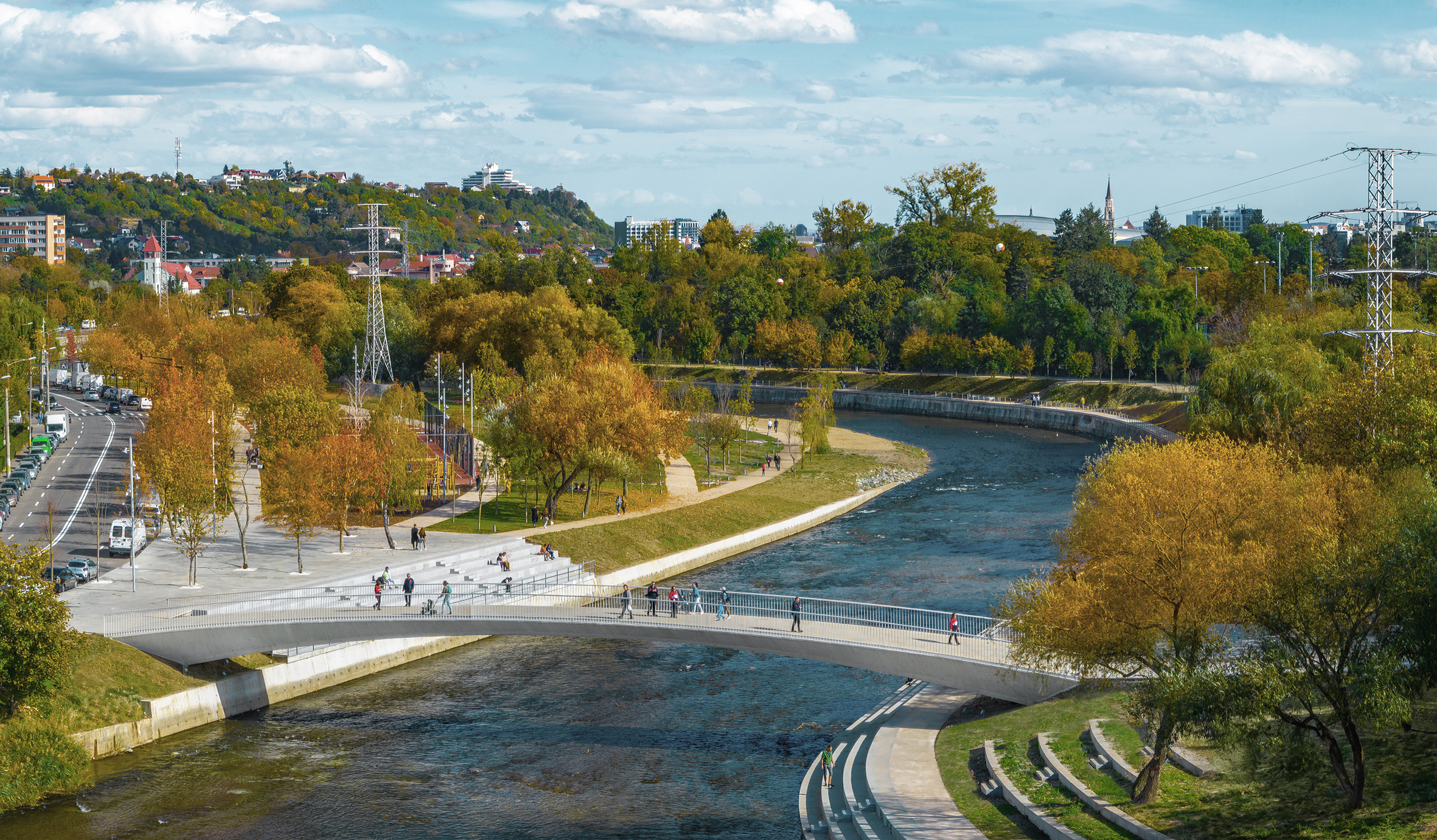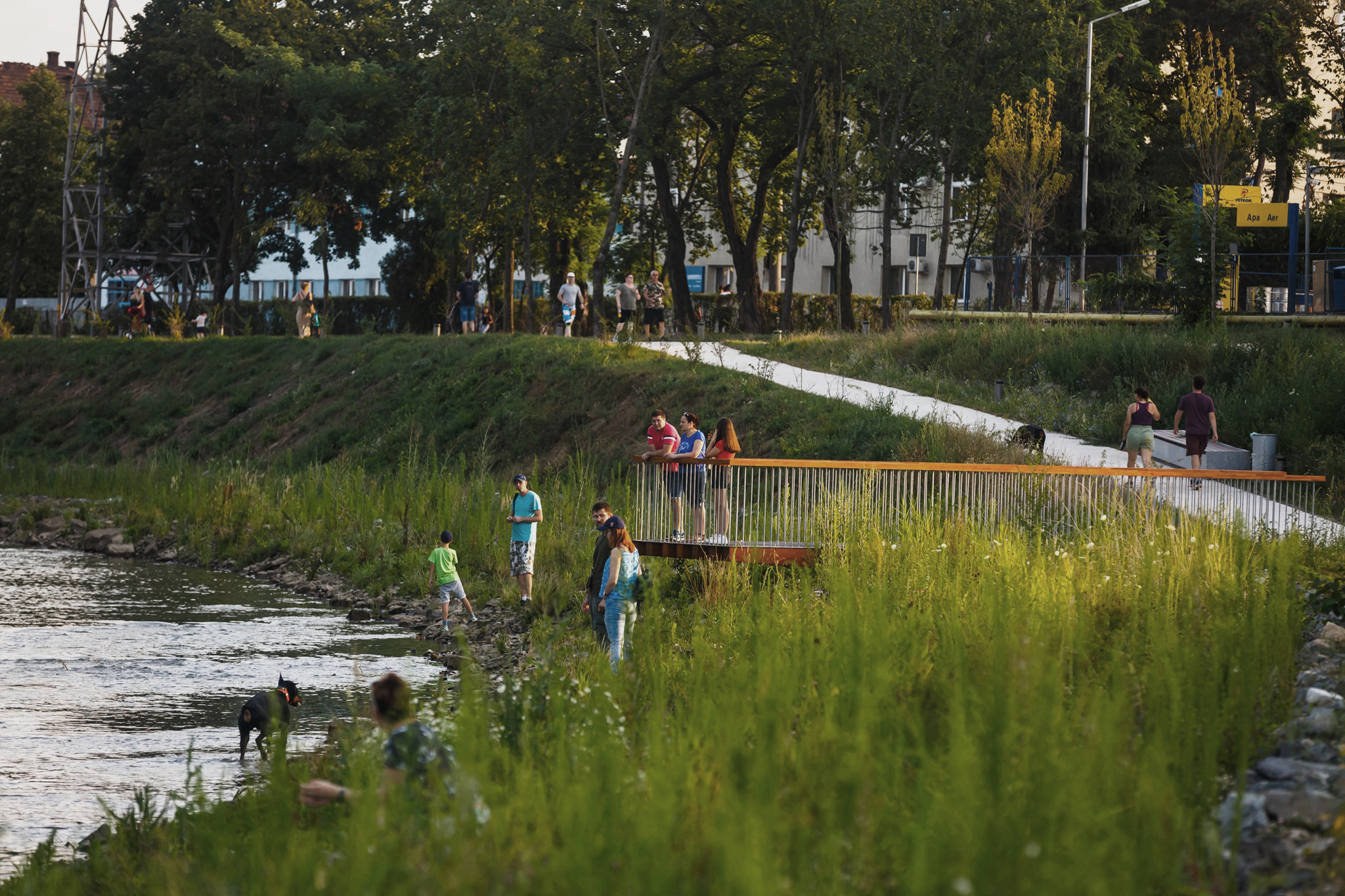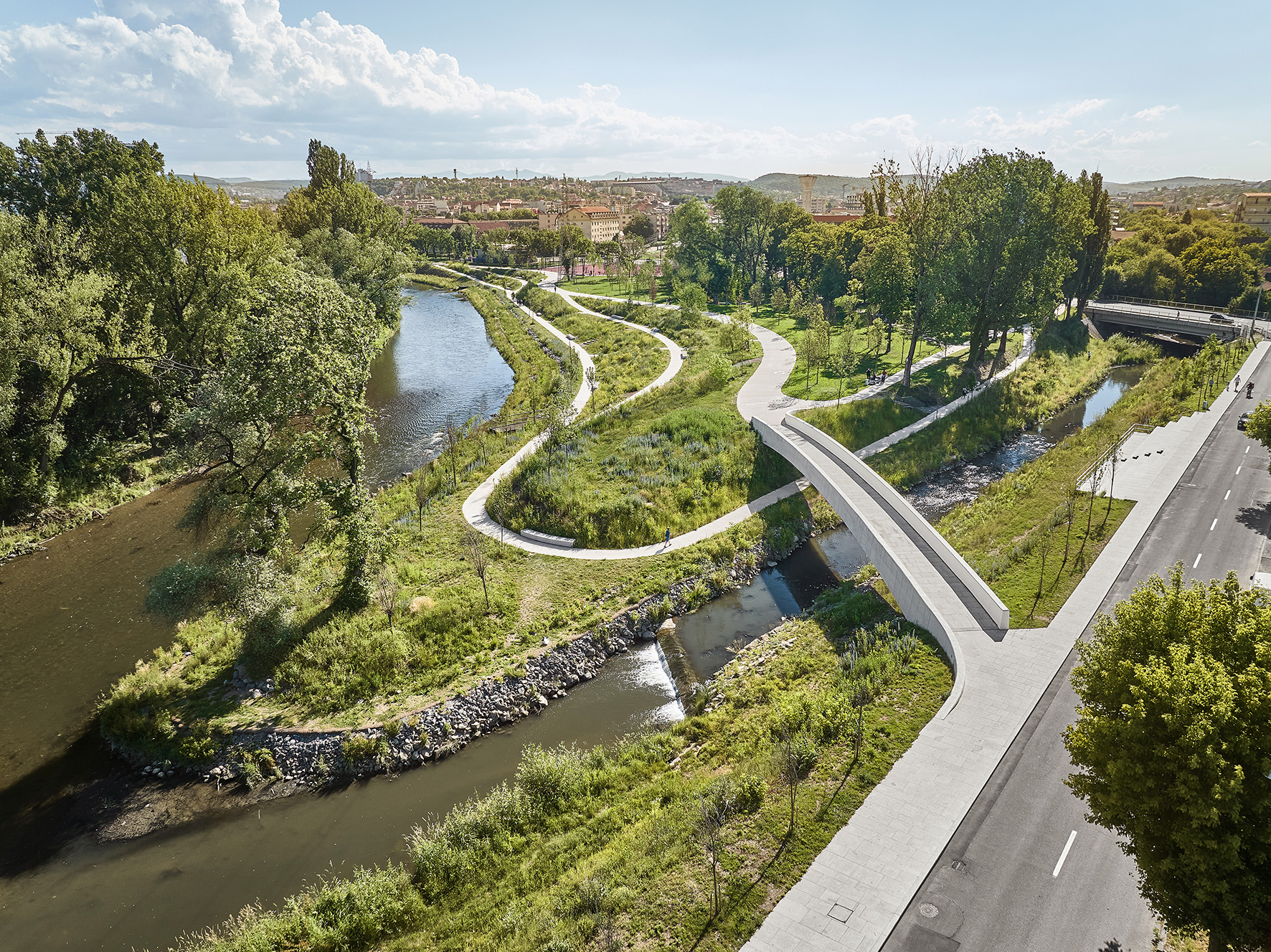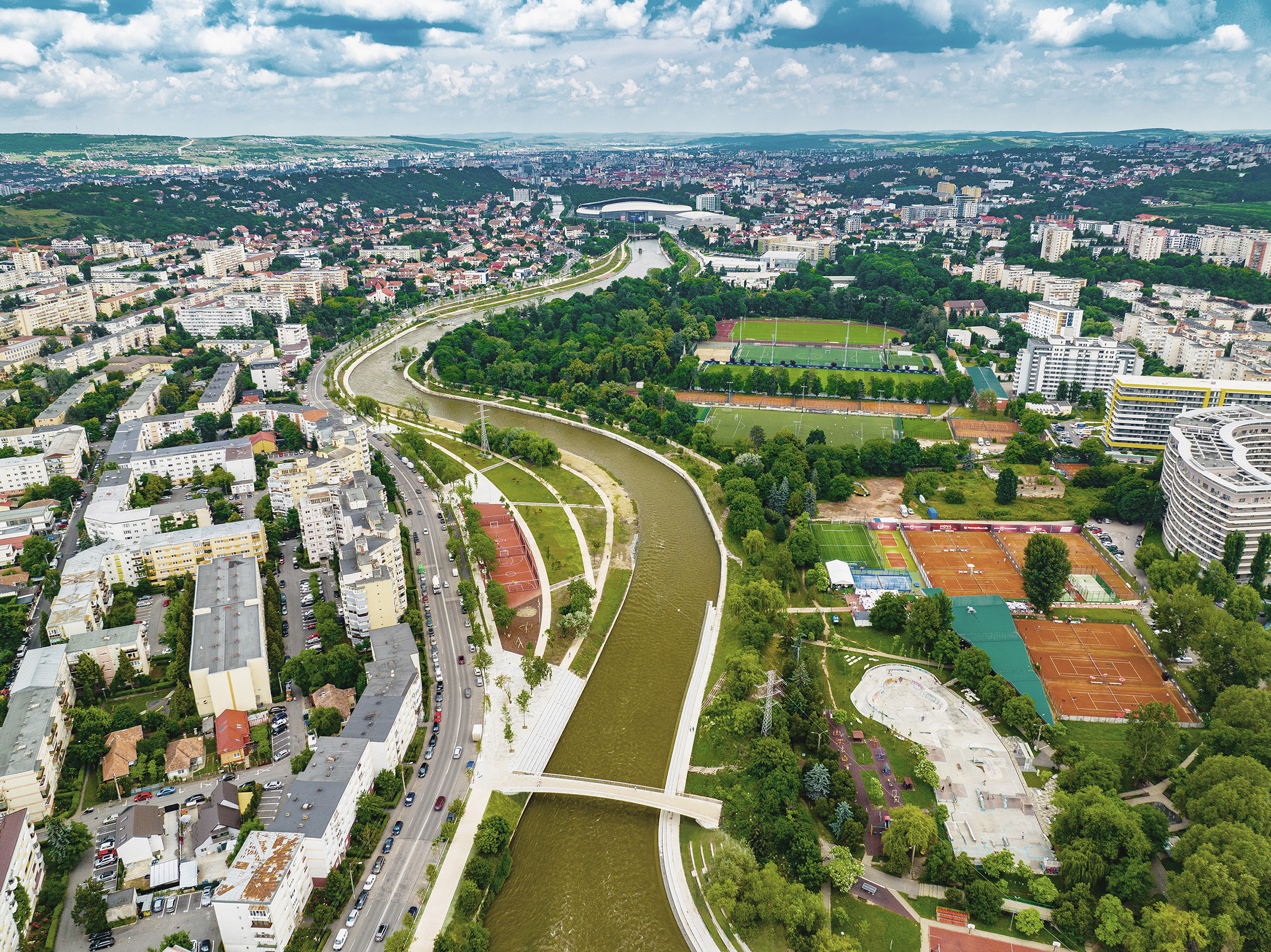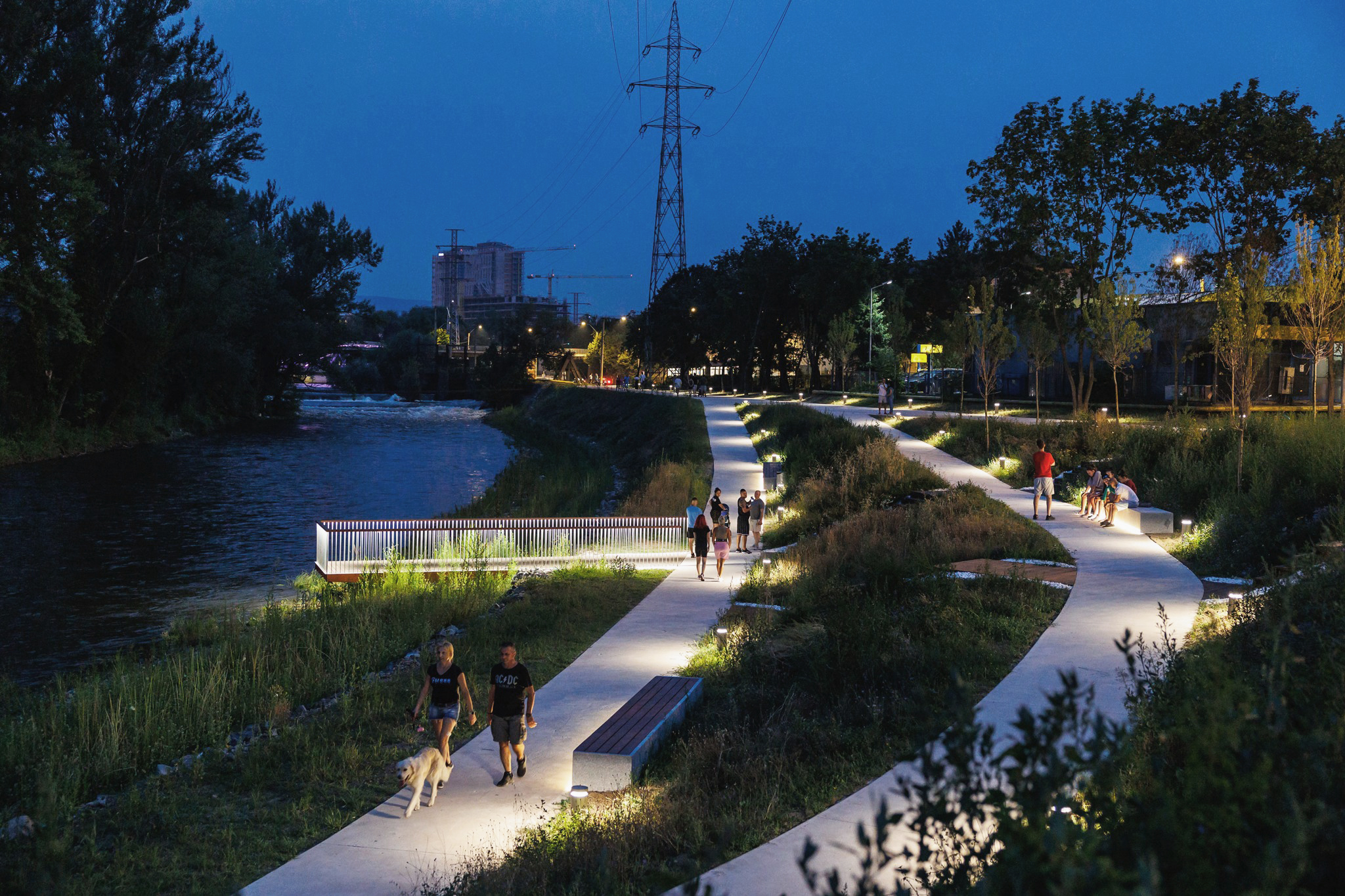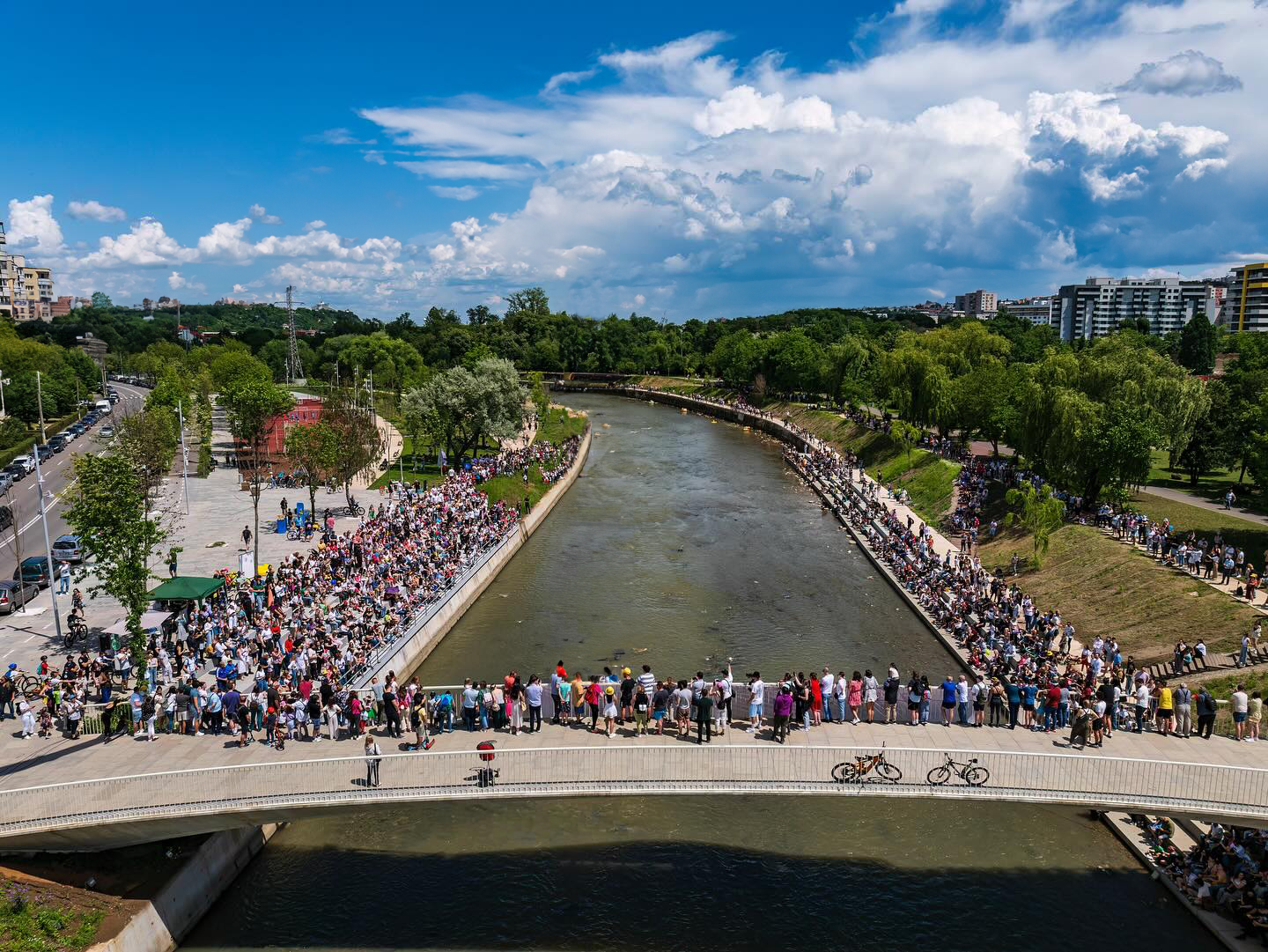Reconnecting with nature
Renaturalization of the River Somes
Renaturalization of the River Somes
Renaturalization of the River Somes is a contemporary example of river regeneration efforts that reimagine the role of the river as it flows through the city of Cluj-Napoca, Romania, for over 15 kilometres. This project incorporates urban and ecological strategies to extend the river's edge, allowing it to merge with the urban fabric. As a result, it becomes the city's primary axis for mobility, activates ecological processes, and serves as a focal point for community engagement.
Romania
Local
Cluj-Napoca, Romania.
Mainly urban
It refers to a physical transformation of the built environment (hard investment)
Yes
2023-12-28
Yes
ERDF : European Regional Development Fund
No
No
As a representative of an organisation
The Renaturalization of the River Somes is a contemporary example of river regeneration and re-naturalization, reimagining the role of the Somes River as it flows through more than 15 kilometres of Cluj-Napoca, Romania.
During the second half of the 20th century, concrete walls were built along the riverbanks, creating a stark elevation difference that severed visual and physical connections between the city and the river.
To restore ecological value and enhance the river’s urban context, the project reclaims the natural character of the riverbanks by widening the river space and reshaping its edges into a system of terraces. This intervention fosters a diverse ecosystem, accommodating local vegetation, rocks, sand, and biorolls. As a result, biodiversity is enhanced, microclimates are formed, CO₂ absorption is increased, and invasive species are controlled.
The proposal envisions the Somes River as a green corridor that stitches together nearby public spaces, green areas, and the broader urban fabric through a network of footpaths, bridges, and cycle tracks. Moreover, new public spaces activate the riverfront: former car parks are transformed into riverfront squares, and banks are designed with beaches and terraces.
Ultimately, the project transforms the river into a vibrant social space operating at multiple scales and hosting diverse programs. It becomes a meeting point for the city’s communities, fostering social interaction and exchange. By reclaiming the riverbanks, the project delivers benefits that transcend social divisions and physical barriers, establishing a participatory infrastructure that responds to both local and global contexts.
During the second half of the 20th century, concrete walls were built along the riverbanks, creating a stark elevation difference that severed visual and physical connections between the city and the river.
To restore ecological value and enhance the river’s urban context, the project reclaims the natural character of the riverbanks by widening the river space and reshaping its edges into a system of terraces. This intervention fosters a diverse ecosystem, accommodating local vegetation, rocks, sand, and biorolls. As a result, biodiversity is enhanced, microclimates are formed, CO₂ absorption is increased, and invasive species are controlled.
The proposal envisions the Somes River as a green corridor that stitches together nearby public spaces, green areas, and the broader urban fabric through a network of footpaths, bridges, and cycle tracks. Moreover, new public spaces activate the riverfront: former car parks are transformed into riverfront squares, and banks are designed with beaches and terraces.
Ultimately, the project transforms the river into a vibrant social space operating at multiple scales and hosting diverse programs. It becomes a meeting point for the city’s communities, fostering social interaction and exchange. By reclaiming the riverbanks, the project delivers benefits that transcend social divisions and physical barriers, establishing a participatory infrastructure that responds to both local and global contexts.
Renaturalization
Biodiversity
River
Connector
Activator
The River Somes project restores the natural character of the riverbanks by transforming narrow, hard edges into a softer, more organic environment. Topographical modifications replace concrete walls, allowing the river to reconnect with its surroundings. A system of terraces creates a gentle gradient between the urban fabric and the river’s natural landscape, fostering a smoother transition between the two.
A key component is the reintroduction of local flora, with 2,212 new trees planted to restore species previously displaced from the riverbanks. Through diverse interventions, the project revitalizes biodiversity and fosters greater collective awareness of the River Somes' ecological and social significance.
The project has significantly expanded green areas by planting thousands of trees and shrubs, enhancing biodiversity along the river and adjacent spaces. For example, Tilia cordata and Tilia tormentosa, accompanied by low bushes, form a buffer between the road and cycle lane. In wider areas like La Plaja and La Butuci Park, clusters of shrubs—including Cornus alba ‘Sibirica’, Lonicera nitida, and Cotinus coggygria—are paired with various prairie types. These meadows are fundamental to the project, offering habitats that encourage biodiversity and trigger the renaturation process.
Dense native vegetation supports high-quality pedestrian and cycling infrastructure, providing CO₂ absorption, weather protection, comfortable microclimates, invasive species control, improved air quality, and vibrant public spaces.
From a sustainability perspective, the construction process is designed to minimize environmental impact. Notably, 74% of materials are reused, 100% are certified or responsibly sourced, and 83% are locally obtained. This approach ensures that the River Somes project not only restores ecological balance but also serves as a benchmark for sustainable urban development.
A key component is the reintroduction of local flora, with 2,212 new trees planted to restore species previously displaced from the riverbanks. Through diverse interventions, the project revitalizes biodiversity and fosters greater collective awareness of the River Somes' ecological and social significance.
The project has significantly expanded green areas by planting thousands of trees and shrubs, enhancing biodiversity along the river and adjacent spaces. For example, Tilia cordata and Tilia tormentosa, accompanied by low bushes, form a buffer between the road and cycle lane. In wider areas like La Plaja and La Butuci Park, clusters of shrubs—including Cornus alba ‘Sibirica’, Lonicera nitida, and Cotinus coggygria—are paired with various prairie types. These meadows are fundamental to the project, offering habitats that encourage biodiversity and trigger the renaturation process.
Dense native vegetation supports high-quality pedestrian and cycling infrastructure, providing CO₂ absorption, weather protection, comfortable microclimates, invasive species control, improved air quality, and vibrant public spaces.
From a sustainability perspective, the construction process is designed to minimize environmental impact. Notably, 74% of materials are reused, 100% are certified or responsibly sourced, and 83% are locally obtained. This approach ensures that the River Somes project not only restores ecological balance but also serves as a benchmark for sustainable urban development.
The River Somes project celebrates and reconnects the city of Cluj-Napoca with one of its greatest assets: the Somes River. In the second half of the 20th century, the river was treated as hard infrastructure for water transport and energy generation. This led to its domestication with concrete walls, creating a sharp elevation gap and fragmenting the visual and physical connection between the city and the river. As a result, the surrounding urban fabric became a series of disconnected spaces lacking continuous paths and cohesive public areas.
To address this, the project reimagines the riverbanks as dynamic public spaces through topographical modifications, continuous pedestrian and cycling paths, and the integration of local vegetation. The design introduces diverse ways to experience the river, including bathing areas, scenic viewpoints, and ecological preservation zones. These spaces offer opportunities for contemplation, leisure, and ecological appreciation, bringing the river closer to the local population and fostering new forms of interaction, recreation, and reflection.
The result is a continuous, accessible riverfront that enhances urban mobility, promotes environmental stewardship, and strengthens social connectivity—transforming the Somes River into a unifying green corridor at the heart of the metropolitan area.
To address this, the project reimagines the riverbanks as dynamic public spaces through topographical modifications, continuous pedestrian and cycling paths, and the integration of local vegetation. The design introduces diverse ways to experience the river, including bathing areas, scenic viewpoints, and ecological preservation zones. These spaces offer opportunities for contemplation, leisure, and ecological appreciation, bringing the river closer to the local population and fostering new forms of interaction, recreation, and reflection.
The result is a continuous, accessible riverfront that enhances urban mobility, promotes environmental stewardship, and strengthens social connectivity—transforming the Somes River into a unifying green corridor at the heart of the metropolitan area.
The topographical modifications and the creation of wider edges in the River Somes project not only restore a structure that aligns more closely with the river’s natural form but also transform the area into a highly accessible public space for all. Accessibility is approached from three key perspectives:
First, the project establishes a network connecting the river with the urban fabric, both longitudinally along the riverbanks and transversely through a system of paths and bridges. This network weaves the river into the city, creating a continuous and seamless connection between the riverfront and surrounding streets.
Second, inspired by the 8-80 Cities concept, which advocates for spaces that are accessible and enjoyable for people of all ages, from children to the elderly, the design incorporates pedestrian pathways and gentle slopes to ensure the riverfront is accessible to everyone, regardless of mobility level. The spaces within the project are carefully designed to accommodate the needs of people with disabilities, the elderly, mothers with children, and others with specific requirements. Additionally, the project considers crucial aspects such as lighting and sightlines, which play a significant role in determining whether certain groups feel comfortable using these spaces. Proper lighting enhances safety and visibility, while well-planned sightlines foster a sense of security and comfort, encouraging people from all backgrounds to enjoy the space.
Finally, the project prioritizes cycling and pedestrian mobility as the main modes of transportation along the river, with the development of 4,840 linear meters of bike paths, 7,996 linear meters of pedestrian paths, and 5,685 linear meters of shared space. A comprehensive system of paths, ramps, and accessible surfaces has been introduced to ensure safe and comfortable movement for both pedestrians and cyclists, fostering a more sustainable and inclusive urban environment.
First, the project establishes a network connecting the river with the urban fabric, both longitudinally along the riverbanks and transversely through a system of paths and bridges. This network weaves the river into the city, creating a continuous and seamless connection between the riverfront and surrounding streets.
Second, inspired by the 8-80 Cities concept, which advocates for spaces that are accessible and enjoyable for people of all ages, from children to the elderly, the design incorporates pedestrian pathways and gentle slopes to ensure the riverfront is accessible to everyone, regardless of mobility level. The spaces within the project are carefully designed to accommodate the needs of people with disabilities, the elderly, mothers with children, and others with specific requirements. Additionally, the project considers crucial aspects such as lighting and sightlines, which play a significant role in determining whether certain groups feel comfortable using these spaces. Proper lighting enhances safety and visibility, while well-planned sightlines foster a sense of security and comfort, encouraging people from all backgrounds to enjoy the space.
Finally, the project prioritizes cycling and pedestrian mobility as the main modes of transportation along the river, with the development of 4,840 linear meters of bike paths, 7,996 linear meters of pedestrian paths, and 5,685 linear meters of shared space. A comprehensive system of paths, ramps, and accessible surfaces has been introduced to ensure safe and comfortable movement for both pedestrians and cyclists, fostering a more sustainable and inclusive urban environment.
Since the project was awarded to an international office, the role of local residents was especially important in the creation of the plan and the design of the project. From the design phase onward, citizens have been actively involved through workshops and public debates, where local residents were invited to provide input on various aspects, such as strategies for space usage, the location of leisure areas, and other key elements. This participatory process ensured that the project addressed the real needs and desires of the community, resulting in a more inclusive and effective design.
The involvement of civil society has been instrumental in shaping the project’s priorities, fostering a sense of ownership and commitment to its success. Feedback from local residents not only helped refine specific aspects of the design but also ensured that the final result was more attuned to the needs of various demographic groups.
The main benefits of the project include:
Woven landscape: The riverfront becomes an integral part of the urban fabric, blending natural and built environments.
Enhancement of the river's value: The river, long overlooked, is now reimagined as a central urban asset, reconnecting people to nature.
Reduction of motorized transport: By offering more sustainable alternatives, such as walking and cycling, the project contributes to a decrease in car use.
Decreased environmental pollution: With fewer cars and increased green space, air quality and noise levels have improved significantly.
Promotion of healthier habits: The design encourages activities like walking, exercise, and cycling, helping residents adopt more active lifestyles.
Overall, the active participation of citizens and civil society has been critical in ensuring the project aligns with local priorities and enhances the quality of life for everyone. This involvement has cultivated a strong sense of community ownership, ensuring that the project benefits all.
The involvement of civil society has been instrumental in shaping the project’s priorities, fostering a sense of ownership and commitment to its success. Feedback from local residents not only helped refine specific aspects of the design but also ensured that the final result was more attuned to the needs of various demographic groups.
The main benefits of the project include:
Woven landscape: The riverfront becomes an integral part of the urban fabric, blending natural and built environments.
Enhancement of the river's value: The river, long overlooked, is now reimagined as a central urban asset, reconnecting people to nature.
Reduction of motorized transport: By offering more sustainable alternatives, such as walking and cycling, the project contributes to a decrease in car use.
Decreased environmental pollution: With fewer cars and increased green space, air quality and noise levels have improved significantly.
Promotion of healthier habits: The design encourages activities like walking, exercise, and cycling, helping residents adopt more active lifestyles.
Overall, the active participation of citizens and civil society has been critical in ensuring the project aligns with local priorities and enhances the quality of life for everyone. This involvement has cultivated a strong sense of community ownership, ensuring that the project benefits all.
The successful design and implementation of the project involved a wide range of stakeholders at different levels, each contributing valuable expertise to ensure the project's alignment with local needs, sustainability goals, and broader regional, national, and European frameworks.
The Project Leader: PRÁCTICA, an international firm, played a central coordinating role. They ensured the vision of the project was aligned with both the city’s needs and global sustainability objectives. Land Lab, as landscape architects, contributed their specialized expertise in ecological restoration, public space design, and sustainability.
Planwerk, as the local architects, focused on ensuring the project was deeply rooted in the urban fabric of Cluj-Napoca. They integrated the vision of PRÁCTICA and Land Lab into the existing architectural and urban context, ensuring that the design was relevant, appropriate, and sensitive to local needs. Aqua Pro, the engineering firm, played a critical role in the technical implementation of the project, particularly in terms of water management.
The local government was actively involved in project management, facilitating approvals, securing funding, and coordinating between different stakeholders to ensure the project adhered to local regulations and policies.
The local community was actively engaged throughout the project, particularly through consultations and workshops, which allowed for a deep understanding of how people in Cluj interact with the river. Their input was crucial in refining the design to better reflect local habits and cultural values. Prominent local organizations such as Jazz in the Park, Somes Delivery, Society of Responsible Consumption, Sustainable Organized Society, and Vamos a la Playa Organization played key roles in contributing unique perspectives. Their collective efforts helped create a more inclusive and sustainable urban transformation.
The Project Leader: PRÁCTICA, an international firm, played a central coordinating role. They ensured the vision of the project was aligned with both the city’s needs and global sustainability objectives. Land Lab, as landscape architects, contributed their specialized expertise in ecological restoration, public space design, and sustainability.
Planwerk, as the local architects, focused on ensuring the project was deeply rooted in the urban fabric of Cluj-Napoca. They integrated the vision of PRÁCTICA and Land Lab into the existing architectural and urban context, ensuring that the design was relevant, appropriate, and sensitive to local needs. Aqua Pro, the engineering firm, played a critical role in the technical implementation of the project, particularly in terms of water management.
The local government was actively involved in project management, facilitating approvals, securing funding, and coordinating between different stakeholders to ensure the project adhered to local regulations and policies.
The local community was actively engaged throughout the project, particularly through consultations and workshops, which allowed for a deep understanding of how people in Cluj interact with the river. Their input was crucial in refining the design to better reflect local habits and cultural values. Prominent local organizations such as Jazz in the Park, Somes Delivery, Society of Responsible Consumption, Sustainable Organized Society, and Vamos a la Playa Organization played key roles in contributing unique perspectives. Their collective efforts helped create a more inclusive and sustainable urban transformation.
In this project, a diverse range of disciplines and knowledge fields converged to create a framework that fosters dialogue and coexistence. The integration of professionals from architecture, landscape architecture, engineering, urban planning, and biological sciences facilitated a holistic approach to design and implementation, ensuring the project’s relevance to both the environment and its users.
The contributions of other disciplines, such as sociology and biology, during the preliminary studies formed the foundation of the project.
The interaction between these disciplines was key to the project’s success. By combining technical expertise with a human-centered approach, the team was able to create a space that not only serves the environment but also fosters social cohesion, providing lasting value to the community.
The contributions of other disciplines, such as sociology and biology, during the preliminary studies formed the foundation of the project.
The interaction between these disciplines was key to the project’s success. By combining technical expertise with a human-centered approach, the team was able to create a space that not only serves the environment but also fosters social cohesion, providing lasting value to the community.
Mainstream practices often prioritize engineering solutions like watercourse channelization. While these approaches are common globally, they frequently result in environmental degradation, disrupting natural ecosystems and compromising long-term sustainability.
In contrast, this project embraced nature-based solutions, a transformative approach that focuses on working with natural processes instead of overriding them. The riverbank regeneration was designed to restore ecological functions and enhance landscape resilience.
The concrete riverbed of the Somes River, a legacy of the Soviet era, has been transformed into a system of soft terraces that activate the renaturalization process. Low ecological footprint materials are used, decomposing and being absorbed by the riverbanks. A biotextile system supports various local shrub species, while coconut netting and fascines help stabilize the earth slopes.
Regarding material sourcing, many come from the project's immediate vicinity. Fascines and earth extracts are sourced directly from the riverbanks for topographical adjustments, while excavated soil from certain areas is repurposed for other sections. Materials like granite come from the Transylvania region, and wood is locally sourced.
By mimicking natural processes, the project aims to restore the area’s ecological balance, improving water quality, supporting biodiversity, and promoting climate adaptation.
In contrast, this project embraced nature-based solutions, a transformative approach that focuses on working with natural processes instead of overriding them. The riverbank regeneration was designed to restore ecological functions and enhance landscape resilience.
The concrete riverbed of the Somes River, a legacy of the Soviet era, has been transformed into a system of soft terraces that activate the renaturalization process. Low ecological footprint materials are used, decomposing and being absorbed by the riverbanks. A biotextile system supports various local shrub species, while coconut netting and fascines help stabilize the earth slopes.
Regarding material sourcing, many come from the project's immediate vicinity. Fascines and earth extracts are sourced directly from the riverbanks for topographical adjustments, while excavated soil from certain areas is repurposed for other sections. Materials like granite come from the Transylvania region, and wood is locally sourced.
By mimicking natural processes, the project aims to restore the area’s ecological balance, improving water quality, supporting biodiversity, and promoting climate adaptation.
The collaborative approach embraced a balanced integration of global and local perspectives, ensuring a dynamic and inclusive methodology for the project.The international firm contributed fresh insights and diverse strategies, enhancing creativity and innovation, while the local team offered a deep understanding of the contextual and cultural conditions, ensuring the design integrated seamlessly with its environment.This collaboration fostered a comprehensive view, blending global best practices with local nuances, enriching the project with a holistic perspective.
A key element of this methodology was the active involvement of stakeholders at various levels, including local communities, event organizers, and the project promoter. Recognizing the importance of diverse viewpoints, the approach facilitated continuous dialogue through initial workshops that helped shape the preliminary project.
The design principles were grounded in shared values among the design team:
Design as a Response to Site and Program Requirements:The design was tailored to address each site's unique features and program needs, ensuring thoughtful, context-sensitive solutions.
Design Conscious of Limited Resources: Sustainable practices were prioritized by making resource-conscious decisions, ensuring responsible utilization throughout the project.
Design with Ecological Consciousness: Ecological awareness guided the design process, ensuring environmental sustainability and harmony with the natural context.
The team's collective experience and expertise ensured the project's consistency and successful execution.
A key element of this methodology was the active involvement of stakeholders at various levels, including local communities, event organizers, and the project promoter. Recognizing the importance of diverse viewpoints, the approach facilitated continuous dialogue through initial workshops that helped shape the preliminary project.
The design principles were grounded in shared values among the design team:
Design as a Response to Site and Program Requirements:The design was tailored to address each site's unique features and program needs, ensuring thoughtful, context-sensitive solutions.
Design Conscious of Limited Resources: Sustainable practices were prioritized by making resource-conscious decisions, ensuring responsible utilization throughout the project.
Design with Ecological Consciousness: Ecological awareness guided the design process, ensuring environmental sustainability and harmony with the natural context.
The team's collective experience and expertise ensured the project's consistency and successful execution.
Despite the site's unique characteristics, the project established a set of principles and strategies that can be replicated in other urban rivers globally.The design methodology, which emphasises ecological regeneration and social inclusion, offers a flexible framework adaptable to various contexts.
A key element that can be transferred is the concept of restoring ecological dynamics by reshaping the river's profile. By restoring natural river processes, the project enhances water management and ecological balance, addressing challenges such as erosion, flooding, and habitat degradation in other rivers.The use of native plant species and the creation of permeable surfaces are also replicable strategies that contribute to water absorption, biodiversity, and soil stabilization.
The project introduces a paradigm shift by treating rivers as green infrastructure, not merely as watercourses. This innovative approach treats rivers as multifunctional spaces, providing socio-ecological services such as improving water quality, acting as wildlife corridors, and promoting climate resilience.Such an approach can be applied to other urban rivers or degraded waterways, transforming them into valuable green spaces that contribute to the urban ecosystem and improve public well-being.
Additionally, the project emphasises the river as a connector, rather than a boundary, between the city's sides, offering potential for replication. By creating spaces that encourage crossing, integration, and community interactions, it fosters social cohesion and enhances public life.This aspect can be applied to other cities with divided communities or urban spaces in need of revitalisation and inclusive design.
A key element that can be transferred is the concept of restoring ecological dynamics by reshaping the river's profile. By restoring natural river processes, the project enhances water management and ecological balance, addressing challenges such as erosion, flooding, and habitat degradation in other rivers.The use of native plant species and the creation of permeable surfaces are also replicable strategies that contribute to water absorption, biodiversity, and soil stabilization.
The project introduces a paradigm shift by treating rivers as green infrastructure, not merely as watercourses. This innovative approach treats rivers as multifunctional spaces, providing socio-ecological services such as improving water quality, acting as wildlife corridors, and promoting climate resilience.Such an approach can be applied to other urban rivers or degraded waterways, transforming them into valuable green spaces that contribute to the urban ecosystem and improve public well-being.
Additionally, the project emphasises the river as a connector, rather than a boundary, between the city's sides, offering potential for replication. By creating spaces that encourage crossing, integration, and community interactions, it fosters social cohesion and enhances public life.This aspect can be applied to other cities with divided communities or urban spaces in need of revitalisation and inclusive design.
The project, though focused on a local scale, addresses significant global challenges with its innovative design and sustainable practices. Climate change is a central issue, with the construction process designed to minimize environmental impact while emphasizing the role of urban rivers in cities. A notable achievement is the use of 74% recycled materials, with 83% of materials locally sourced and all being responsibly certified. In addition, the planting of more than 2,000 trees aims to create a microclimate and mitigate urban heat islands. These sustainable strategies not only reduce the environmental footprint but also contribute to a circular economy.
The integration of hard infrastructure plays a key role in promoting sustainable mobility. The project introduces strategies to reduce CO2 emissions by prioritizing walking, cycling, and public transportation over private vehicle use. These shifts aim to alleviate traffic congestion, improve air quality, and promote a healthier, more sustainable urban environment. Notable changes include the redesign of streets such as Strada Mamaia, Strada Toduță, Bulevardul 1 Decembrie 1918, and Strada Gavril Muzicescu, where parking spaces were replaced with bike lanes and shared spaces. These efforts align with the global commitment to combat climate change.
Ecological restoration and the re-naturalization of the local environment are also central to the project. Restoration initiatives focus on enhancing the ecological values of the river, such as reintroducing native species and revitalizing the landscape’s natural features. These actions are aimed at improving biodiversity, water quality, and creating a more resilient environment that can better withstand climate change. By restoring these ecological functions, the project not only addresses local environmental concerns but also supports global conservation efforts, contributing to a more sustainable and biodiverse ecosystem.
The integration of hard infrastructure plays a key role in promoting sustainable mobility. The project introduces strategies to reduce CO2 emissions by prioritizing walking, cycling, and public transportation over private vehicle use. These shifts aim to alleviate traffic congestion, improve air quality, and promote a healthier, more sustainable urban environment. Notable changes include the redesign of streets such as Strada Mamaia, Strada Toduță, Bulevardul 1 Decembrie 1918, and Strada Gavril Muzicescu, where parking spaces were replaced with bike lanes and shared spaces. These efforts align with the global commitment to combat climate change.
Ecological restoration and the re-naturalization of the local environment are also central to the project. Restoration initiatives focus on enhancing the ecological values of the river, such as reintroducing native species and revitalizing the landscape’s natural features. These actions are aimed at improving biodiversity, water quality, and creating a more resilient environment that can better withstand climate change. By restoring these ecological functions, the project not only addresses local environmental concerns but also supports global conservation efforts, contributing to a more sustainable and biodiverse ecosystem.
The project has achieved significant results and impacts, benefiting both direct and indirect beneficiaries, particularly the 323,484 citizens of Cluj-Napoca. Of these, around 108,000 individuals directly benefit from the improvements.One of the key outcomes is the appropriation of the river and public spaces, fostering a stronger connection between the community and its natural environment.
The project has promoted mobility and enhanced quality of life through the creation of sustainable infrastructure.In terms of mobility, the construction of 4,840 linear metres of cycle paths and 7,996 linear metres of pedestrian paths has significantly improved connectivity, while 5,685 linear metres of shared space have been created, enhancing the safety and accessibility of public areas for all users. Pedestrian and cycling routes are now continuous, reducing travel times and promoting sustainable transportation options. These improvements have led to a reduction in traffic congestion, further encouraging the shift towards eco-friendly mobility.Notably, the project has increased bicycle traffic by 250%, reflecting a successful shift towards more sustainable forms of transport.
Ecologically, the project has focused on the re-naturalization of the river environment, with the introduction of native vegetation to restore ecological functions and enhance biodiversity. The planting of more than 2,000 trees helps to mitigate urban heat islands and contributes to the creation of a microclimate, improving air quality and the overall urban environment.The total area of green space after the project is 11.3 hectares, which represents a significant expansion of the city's green infrastructure.The restoration of the ecological values of the river has further strengthened its role as a vital natural asset, benefiting both the local community and the broader ecosystem.
The project has promoted mobility and enhanced quality of life through the creation of sustainable infrastructure.In terms of mobility, the construction of 4,840 linear metres of cycle paths and 7,996 linear metres of pedestrian paths has significantly improved connectivity, while 5,685 linear metres of shared space have been created, enhancing the safety and accessibility of public areas for all users. Pedestrian and cycling routes are now continuous, reducing travel times and promoting sustainable transportation options. These improvements have led to a reduction in traffic congestion, further encouraging the shift towards eco-friendly mobility.Notably, the project has increased bicycle traffic by 250%, reflecting a successful shift towards more sustainable forms of transport.
Ecologically, the project has focused on the re-naturalization of the river environment, with the introduction of native vegetation to restore ecological functions and enhance biodiversity. The planting of more than 2,000 trees helps to mitigate urban heat islands and contributes to the creation of a microclimate, improving air quality and the overall urban environment.The total area of green space after the project is 11.3 hectares, which represents a significant expansion of the city's green infrastructure.The restoration of the ecological values of the river has further strengthened its role as a vital natural asset, benefiting both the local community and the broader ecosystem.

